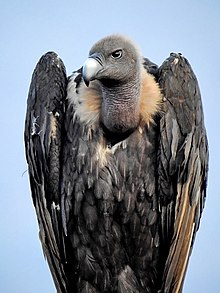

Nine species of vulture can be found living in India, but most are now in danger of extinction after a rapid and major population collapse in recent decades.[1][2] In the early 1980s, three species of Gyps vultures (the white-rumped vulture, the long-billed vulture and the slender-billed vulture) had a combined estimated population of 40 million in South Asia, while in 2017 the total population numbered only 19,000 (6,000, 12,000, and 1,000 respectively).
With a loss of over 99% of all the population of vultures, the Indian vulture crisis represents the sharpest decline of any animal in the given period.[3] A major contributing factor in declining populations of vultures is believed to be the widespread use of drugs such as diclofenac, a nonsteroidal anti-inflammatory drug (NSAID) once commonly given to livestock. The drug is believed to have been passed onto the vultures through the flesh of dead cattle who were given diclofenac in their last days of life, which then causes kidney failure in vultures.[4] Data modelling revealed that a tiny proportion (about 0.8%) of livestock carcasses containing diclofenac can cause significant crash in vulture populations.[5]
Without vultures, a large number of animal carcasses were left to rot, posing a serious risk to human health by providing a potential breeding ground for infectious germs and proliferation of pests such as rats.[6] The loss of vultures also resulted in a substantial increase in the population of feral dogs, whose bites are the most common cause of human rabies. The feral dog population in India increased by least 5 million, resulting in over 38 million additional dog bites and more than 47,000 extra deaths from rabies, costing $34 billion in economic impact.[4]
Veterinary usage of diclofenac has been banned in India since 2006.[7][8] Meloxicam, another NSAID, which was rapidly metabolized and harmless to vultures, was suggested as an acceptable substitute for diclofenac.[9] In addition, various conservation schemes are in place to help recover the vulture population.[10] The population is recovering slowly and the decline has been significantly arrested in India, Pakistan and Nepal following a strict ban on the drugs causing harm to the vultures.[11][4][12]
- ^ "IUCN red list". IUCN. Archived from the original on June 27, 2014. Retrieved 13 August 2015.
- ^ "Conserving South Asia's Threatened Vultures". Save Our Species. Archived from the original on 13 September 2015. Retrieved 13 August 2015.
- ^ "Sharp decline in vulture population, from 40 million to 19,000: Prakash Javadekar". The Hindu. 19 July 2019. Retrieved 23 August 2023.
- ^ a b c Ian Burfield; Chris Bowden (28 September 2022). "South Asian vultures and diclofenac". Cambridge University. Retrieved 23 August 2023.
- ^ Kamakshi Iyer (19 August 2021). "Born to be wild: India's first captive-bred endangered vultures set free". The Guardian. Retrieved 23 August 2023.
- ^ Prakash, V.; Pain, D.J.; Cunningham, A.A.; Donald, P.F.; Prakash, N.; Verma, A.; Gargi, R.; Sivakumar, S. & Rahmani, A.R. (2003). "Catastrophic collapse of Indian white-backed Gyps bengalensis and long-billed Gyps indicus vulture populations". Biological Conservation. 109 (3): 381–390. Bibcode:2003BCons.109..381P. doi:10.1016/S0006-3207(02)00164-7.
- ^ "Diclofenac Ban". Archived from the original on 2020-02-25. Retrieved 2020-02-25.
- ^ "Indian courts ban multi-dose vials of Diclofenac – another step in the right direction to save Southern Asia vultures from extinction". Vulture Conservation Foundation. 4 November 2017. Archived from the original on 30 April 2020. Retrieved 25 June 2020.
- ^ Adawaren, Emmanuel Oluwasegun; Mukandiwa, Lillian; Chipangura, John; Wolter, Kerri; Naidoo, Vinny (1 January 2019). "Percentage of faecal excretion of meloxicam in the Cape vultures (Gyps corprotheres)". Comparative Biochemistry and Physiology Part C: Toxicology & Pharmacology. 215: 41–46. doi:10.1016/j.cbpc.2018.10.001. hdl:2263/67172. PMID 30336288. Retrieved 23 August 2023.
- ^ Kinver, M. (31 Jan 2014). "Project targets 2016 for Asian vultures release". BBC News. Retrieved 2 February 2014.
- ^ "Indian Vulture factsheet". birdlife.org. Retrieved 25 August 2023.
- ^ Rajat Ghai (17 January 2019). "Madhya Pradesh's vulture population increases". Times of India. Retrieved 23 August 2023.